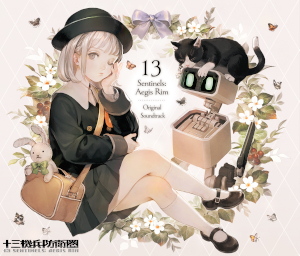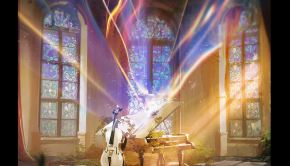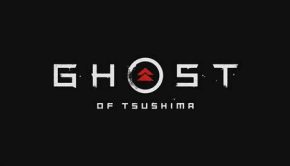13 Sentinels: Aegis Rim Original Soundtrack
 |
Album Title: 13 Sentinels: Aegis Rim Original Soundtrack |
| Record Label: Basiscape Records |
|
| Catalog No.: BSPE-1091~4 |
|
| Release Date: February 27, 2020 |
|
| Purchase: Buy at iTunes |
Overview
The 13 Sentinels: Aegis Rim Original Soundtrack features the soundtrack to the game of the same title, a hybrid game featuring tactical defense battles against large kaiju and a story revolving around 13 different individuals. The music, composed by Hitoshi Sakimoto and members of Basiscape, past and present, is, much like the game itself, a hybrid soundtrack featuring electronic and orchestral elements, with each composer offering a unique voice to add to the musical palette. How does the soundtrack for Vanillaware’s latest project turn out compared to previous Vanillaware soundtracks?
Body
The album opens up with the main theme, “Brat Overflow,” composed by Hitoshi Sakimoto. It’s an excellent tune in setting the stage for the rest of the stage. A vocal theme with a largely electronic backing and some orchestral accompaniment gives the impression of a futuristic sci-fi setting. The melody itself is fantastic and the vocals add an energetic and determined sound. It’s wonderful seeing Sakimoto at the helm of an electronic tune once again. The main theme motif is also present in other tunes. Both “A Brave Gene” and “A F8ful Struggle” offer strings renditions with the former leaning towards somber with some brass harmonise and the latter being dramatic and hopeful with lovely piano textures. It is also used in the final battle theme, “-{EDGE OF THE FUTURE}-,” a blend of the orchestral and the electronic. Like much of the battle themes, which will be mentioned later in the review, the piece transitions a few times as it progresses. From a synth heavy start, the instrumental main theme is hopeful and determined in nature. As it progresses, orchestral elements are introduced and take center stage, turning the piece into a more dramatic affair where everything is at stake. Lastly, the vocals heard in “Brat Overflow” are added and the main theme makes its appearance with some added orchestral harmonies, making things come full circle. It’s an excellent tune and helps close out the action in the game with stunning effect. The main theme is also present in some of the conclusion tracks, “The Ones Who Were Plugged In” and “The Only Neat Life to Live.” The former is a tune with a moody, futuristic atmosphere with mysterious synthesizers alongside a strings rendition of the main theme that crescendos into more intense orchestral passages as it progresses. The latter is a more vibrant and hopeful rendition of the main theme that is preceded by atmospheric electronic music. It’s a great way to close out the soundtrack.
Following the main theme is “KAIJU,” a dramatic orchestral tune with presence and a sense of tension, while the brass focus gives off a bit of a cacophonous attribute, fitting for its usage. “IMMINENT” is another dramatic orchestral tune with a wonderful melody full of dark and tense passages. “Lonely Struggle” reeks of desperation but with a melody that is beautiful and poignant. Other orchestral focused tunes include “RESOLUTION,” a tune with a determined sound with an uplifting melody that focuses on strings and heavy percussion hits with some electronic accompaniment and “To the Final Battle,” another determined tune with strings and brass elements alongside pulsing electronic beats. The tune itself is a bit ominous, but fitting for what’s at stake. Likewise, “Last Line of Defense” also carries a sense of urgency with its orchestral and electronic fusion with a crescendo of intensity as it progresses. A personal favorite is “A Cruel Thesis,” a more somber strings-based piece with its beautifully haunting melody that also provides a more ethereal touch with the soft electronica and piano additions. “Self-Sacrifice” is also a somber tune with strings and angelic vocals taking center stage. The use of light electronic accompaniment also adds some musical texture as well.
There are also plenty of mood setting pieces as well. “LONER” is a pensive electronica based tune that blends acoustic guitar, piano, and strings to create a great atmosphere through its execution and beautiful melody. “BUDDIES” is more piano focused, with some electronic accompaniment and percussion. Through the use of acoustic guitar, a twangy sound and an uplifting atmosphere is presented. There are also some electronica elements as well giving the a darker and more dramatic flair. “Staring into the Void” is contemplative and mysterious with its piano focus and melody. It’s a highlight for sure. “Heated Debate” features piano, acoustic guitar, and strings to create a warm presence and a poignant air. The strings melody is features a motif also present in the battle theme, “PHENYLALANINE.” Lastly, “The One” is a cello and piano tune with a beautiful melody conveying a sense of hope with ethereal vocals and acoustic guitar to help lift up the bright and peaceful melody.
Of course, given the nature of the game, there are plenty of tunes that help amplify the sense of mystery in the game. “UNPREDICTABLE” is one such tune, with its strings work providing a mysterious and somber air with its haunting melody while “Stagnation” blends piano, electronica, strings, and percussion to give a mysterious and nostalgic effect, as if playing off an old phonograph. “SEEKER,” on the other hand, provides a more atmospheric touch with its industrial and gritty electronic sound. “Sneaking Suspicions,” like its title, is rather mysterious and atmospheric with its electronica and strings approach while “Between the Lines” focuses on mystery with its piano melody, further accentuated by the strings accompaniment and atmospheric textures. “Bad Omen” is jazzier, focusing on piano and strings, but still features a strong atmospheric touch. “The Plot Thickens” is one of the stronger pieces with its piano, electronica, and percussive focuses, resulting in an exquisite atmosphere that highlights the mystery at hand. There are also some more electronic focused pieces that help set the tone. “The Tower of Knowledge” carries a futuristic tone full of mystery and tension, helping create a strong atmospheric touch, perfect for a sci-fi setting. Likewise, “Voyage to Tomorrow” also carries a futuristic vibe to it with its synth focus. It’s mysterious and tense, with great percussion and electronic rhythms that help support the “into the unknown” aspect of the music.
There are also tunes that capture the essence of everyday life in the game. “In the Doldrums” is a bright and vibrant piece with a strong melody, jazzy piano, and woodwinds alongside light electronic percussion that captures the futuristic sci-fi sound quite nicely. “Mornin’ Sunshine!” is another vibrant piece, but one with a peaceful atmosphere. The melody itself is exquisite and the piano and mallet percussion are highlights to the piece. A personal favorite is “Halcyon Days,” offering up a blend of synthesizer, light electronic percussion, with the core of the piece being a piano and English horn melody that gives off a plucky and upbeat vibe. Likewise, “Good Times,” with its acoustic guitar piano, and strings based approach is upbeat and the synthesizer and electronic accompaniment give it a more sci-fi sound. “Bright Days Ahead” is peppy and fun with its bubbly strings and piano melody and electronic accompaniment. On the other hand, “Forty Winks” is more atmospheric, giving it a dream-like quality, supported by keyboard, piano, and plucky synths. “Fancy Some Tea?” is a more peaceful sound as well, with keyboard and strings offering up a beautiful melody and atmosphere.
One of the biggest draws to the soundtrack, in my opinion, are those related to the tactical battles featured in the game. These pieces are typically the longest in the game and also feature a variety of transitions. Present within each tune is also a unique victory theme that carries the same melody as the battle theme itself, often in a lighter soundscape. I wish the victory theme aspects of each tune were a separate track, as with most of the pieces, the transitions from battle theme to victory theme are typically rather abrupt, making them stick out more and interrupting the flow of the battle energy heard in the rest of the tune. Each composer offers their own take on the battle themes and each are differentiated by their sound. When it comes to Yoshimi Kudo, who offers the most of any of the composers, his tunes are very high energy, full of frenetic strings work and varying degrees of electronic intensity. “VALINE” is an earlier piece on the soundtrack and features a more synthy sound with a nice sense of buildup. As it transitions throughout the piece, more industrial tones are introduce and the strings and electronic elements become more intense. The victory theme is also rather calm and relaxing. “LEUCINE” and “ISOLEUCINE” both follow a similar approach. The former opens up with peppy synth and more solemn strings work before becoming more determined in sound and a fusion of intense strings and electronic work. The latter is certainly one of the heavier tunes. It’s more synth heavy in the melody, although does feature many sections with strings and brass. The middle section, with its industrial and heavy electronic sound is fantastic and helps give it a unique edge over some of Kudo’s other contributions. The strings melody in the final section is absolutely wondrous and really elevates the end piece. The victory theme is a bit grittier than others and captures the organic and electronic components of the theme rather nicely. Kudo’s final contribution is “DEOXYRIBOSE,” the first part of the final battle sequence. It captures the sense of urgency and intensity of the battle with its orchestral and electronic fusion. However, it also introduces electric guitar to help add a new texture to the piece. The strings work throughout is frenetic and the piece itself is reminiscent of his work on Raiden V. Choral elements add a softness to the melody and are utilized to break up the tension and, at times, cold and industrial aspects of the piece. It’s a stunning piece and one of my favorites on the soundtrack.
Mitsuhiro Kaneda also offers a fair amount of battle themes on the album, each with a different feel, and one aspect of Kaneda’s tracks that I particularly enjoy, is how the transitions from section to section feel less forced than some of Kudo’s. . “LYSINE” is more synthesizer focused, giving it a futuristic, sci-fi feel with a moody melody, ethereal synths, and groovy bass line. The introduction of strings work adds an organic touch to the piece as the piece progresses and the pulsing electronic beat helps add some tension. It is an exquisite tune with a fantastic melody that is one of the powerhouses on the album. His approach to “PHENYLALALINE” is to blend strings and electronic elements more prominently throughout the piece. The opening section features a more atmospheric synth accompaniment with a reflective and somber violin melody before transitioning into a brass and strings orchestral focus over and energetic beat. The colder more synthy sections add a great sense of tension, particularly with the sharp orchestral hits. The final section offers a more hopeful sound to contrast with how the piece initially starts. As mentioned before, the melody in “PHENYLALALINE” is present in another tune, but it also appears in Kaneda’s last contribution to the battle scene, “RIBOSE.” This tune is more dramatic, epic, ominous, and tense with its brass dominated melody and light electronic elements. As it progresses, it gets a bit colder with its industrial elements while the solo violin melody adds a touch of mystery and features the motif present in “PHENYLALANINE.”
The other two composers that offer battle themes are Rikako Watanabe and Yukihiro Kikuchi. Watanabe’s “THREONINE” is absolutely stunning, focusing more on synthesizer than live instrumentation, giving it a more futuristic sound. Its icy synths and cold accompaniment help add tension and the industrial focus as it progresses adds a nice texture to the piece. The melody itself is fantastic and the sparse usage of live instrumentation and synthesized choir further highlights the inorganic components of the piece. Her other piece, “TRYPTOPHAN” also takes a similar approach focusing less on live instrumentation, although used at times. This piece, more so than the former, sounds like it would fit perfectly in a shmup with its wonderful synth melody accompanied by atmospheric synths, electronic layering, and a great sense of progression, becoming more frenetic as it goes on. Kikuchi’s “THREONINE” is an electronic and orchestral fusion accompanied by a beat that is very dance club oriented. The brass focus on melody gives it a heroic sound and the accompaniment is always engaging. As it gets more tense, the beat becomes a bit more standard and the melody a bit more staccato, giving it a bit of a militaristic touch and there is some dubstep influence in certain aspects of the piece. The intensity of the piece towards the end is quite strong with a heavier focus on percussion and weightier strings and brass elements. The end result is quite strong. Lastly, “HISTIDINE,” compared to the other tunes, is largely less intense. There are some wispy elements, plenty of atmospheric synths, and a more subdued melody, at least initially. It has a very futuristic shmup vibe. As it progresses, the melody is more prominent ahd the additiosn of jazzy chords and distorted synths help give it some more intense texture. It’s another strong theme with a great melody.
Summary
The 13 Sentinels: Aegis Rim Original Soundtrack is an absolute powerhouse by Basiscape composers. Fitting for its futuristic tale mixing a more narrative game with tactical battles in between, it offers a variety of soundscapes, from more upbeat and lighthearted to dark, tense, and mysterious moments. The battle themes are perhaps the strongest aspect to an extremely strong atmospheric and cinematic soundtrack. Fans of Basiscape will certainly find plenty to enjoy, especially if they enjoy the contributions from the various composers under its employ. Like other Vanillaware soundtracks, this one is not to be missed.
Do you agree with the review and score? Let us know in the comments below!
5
Posted on June 26, 2020 by Don Kotowski. Last modified on June 26, 2020.














